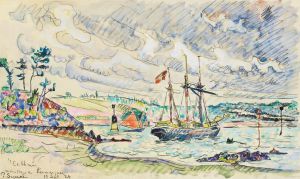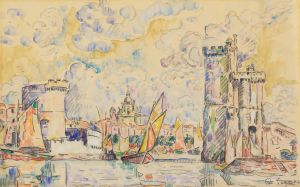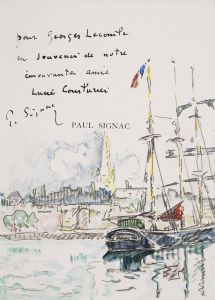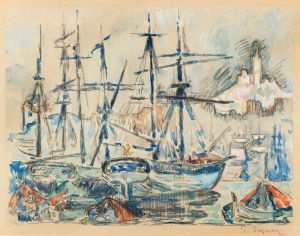
Le Conquet
A hand-painted replica of Paul Signac’s masterpiece Le Conquet, meticulously crafted by professional artists to capture the true essence of the original. Each piece is created with museum-quality canvas and rare mineral pigments, carefully painted by experienced artists with delicate brushstrokes and rich, layered colors to perfectly recreate the texture of the original artwork. Unlike machine-printed reproductions, this hand-painted version brings the painting to life, infused with the artist’s emotions and skill in every stroke. Whether for personal collection or home decoration, it instantly elevates the artistic atmosphere of any space.
Paul Signac's painting "Le Conquet" is a notable work by the French Neo-Impressionist artist, who was a leading figure in the development of the Pointillist technique alongside Georges Seurat. Signac was born in Paris in 1863 and initially pursued architecture before dedicating himself to painting. His artistic journey was significantly influenced by Impressionism, but he later became a pioneer of Neo-Impressionism, a movement characterized by the use of small, distinct dots of color applied in patterns to form an image.
"Le Conquet" is a representation of the coastal town of Le Conquet, located in Brittany, France. This region was a popular subject for many artists due to its picturesque landscapes and vibrant maritime life. Signac was particularly drawn to the sea and often depicted ports, boats, and coastal scenes in his work. His fascination with the sea is evident in "Le Conquet," where he captures the essence of the coastal environment with his distinctive style.
The painting exemplifies Signac's use of the Pointillist technique, which involves applying small dots of pure color to the canvas. This method allows the viewer's eye to blend the colors optically, creating a luminous effect that is characteristic of Signac's work. The technique was inspired by scientific theories of color and optics, which were being explored during the late 19th century. Signac believed that this approach could achieve greater vibrancy and harmony in art.
In "Le Conquet," Signac employs a palette of bright, contrasting colors to depict the natural beauty of the Brittany coast. The painting captures the dynamic interplay of light and water, with the sea rendered in various shades of blue and green, reflecting the sky and surrounding landscape. The use of color in "Le Conquet" not only conveys the physical attributes of the scene but also evokes a sense of atmosphere and mood, inviting the viewer to experience the tranquility and vitality of the coastal setting.
Signac's work, including "Le Conquet," had a significant impact on the development of modern art. His exploration of color theory and innovative techniques influenced a generation of artists, including Henri Matisse and the Fauves, who further expanded the boundaries of color and form in painting. Signac's commitment to the principles of Neo-Impressionism and his dedication to capturing the beauty of the natural world continue to be celebrated in art history.
"Le Conquet" is a testament to Signac's mastery of the Pointillist technique and his ability to convey the essence of a place through color and composition. The painting remains an important example of Neo-Impressionism and reflects Signac's enduring legacy as an artist who sought to harmonize scientific principles with artistic expression.

















